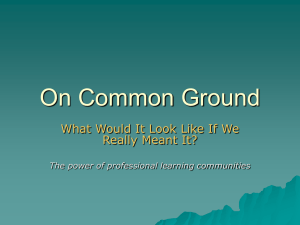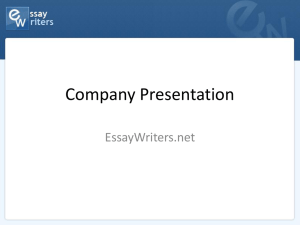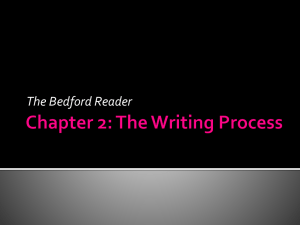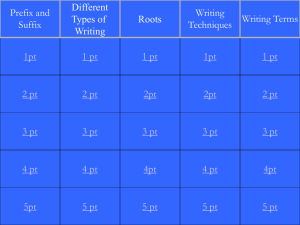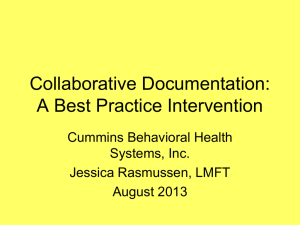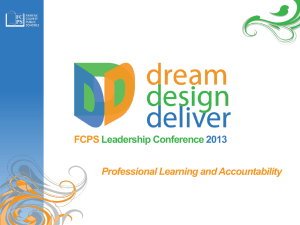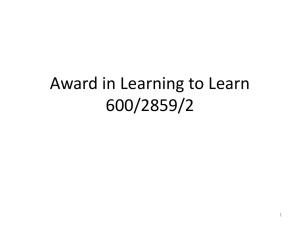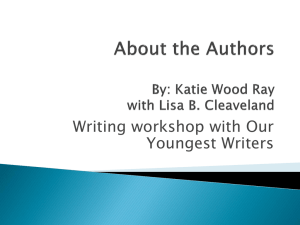On Common Ground The Power of Professional Learning
advertisement
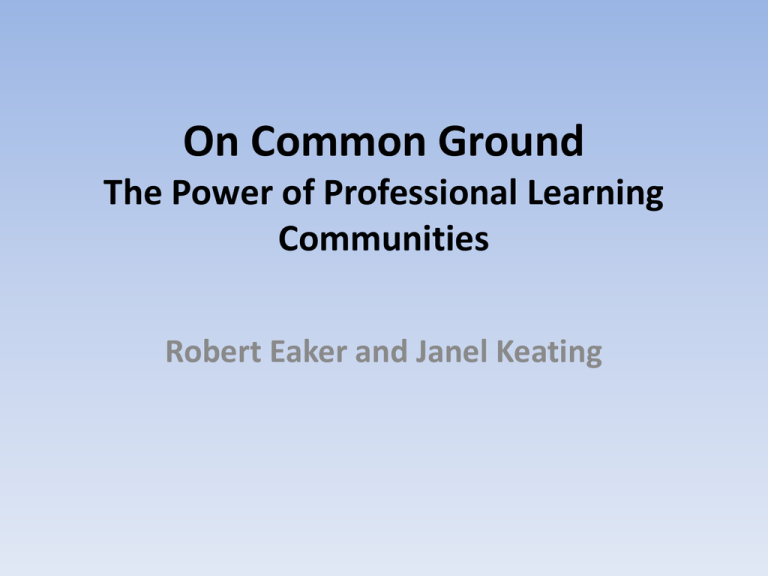
On Common Ground The Power of Professional Learning Communities Robert Eaker and Janel Keating An Age of Uncertainty To borrow from Charles Dickens, these are perhaps the “best of times and the worst of times” for American public education. For sure, it is an age of uncertainty! Educators are being called upon to educate, at high levels, all students. Although few would argue that this is certainly a worthwhile goal, success has proven to be problematic. On the other hand, we know more than we’ve ever known about how to successfully improve schools. This fact, in-and-of itself, has created a challenge for educators. With such a plethora of reform initiatives, researchers, and writers, educators are faced with a myriad of approaches, terms and concepts—so many, in fact, that many educators simply do not know where to turn or what to believe. Good News! However, there is some good news! There are some things about which there is a growing certainty. One of these, the concept of schools functioning as professional learning communities, presents a relatively simple way of thinking about how to embed “best practices” into a single school improvement framework. On Common Ground Consider these observations of Mike Schmoker concerning the professional learning community concept as a way to improve schools. “So, what if there was, right now, a fairly straightforward, well-established way to appreciably improve both teaching quality and levels of learning? What if evidence from numerous schools and the research community points to proven structures and practices that (1) stand to make an immediate difference in achievement and (2) require reasonable amounts of time and resources? The fact is that such structures and practice do exist and there is no reason to delay their implementation.” “We’ll know we have succeeded when the absence of a ‘strong professional learning community’ in a school is an embarrassment.” --Mike Schmoker In fact, perhaps never before in the history of American public education has there been such wide-spread agreement among researchers, writers and practitioners alike regarding the most promising path to improving America’s schools. Consider the following: Researchers and Writers Virtually every prominent educational researcher and writer has endorsed the concept of schools functioning as professional learning communities. Here are but a few: Linda-Darling-Hammond, Doug Reeves, Bob Marzano, DuFour, DuFour & Eaker, Rick Stiggins, Jonathon Saphier Dennis Sparks, Michael Fullen, Roland Barth, Mike Schmoker, Larry Lezotte, Andy Hargreaves, Dylan Wiliam, Shirley Hord, Phil Schlecty, Carl Glickman, Richard Elmore, and many, many more! Practitioners In addition to schools and school districts in every state successfully embedding professional learning community concepts and practices, virtually every major educational organization--including the National Education Association and the American Federation of Teachers—has endorsed the professional learning community concept! Professional Learning Communities: A Way of Thinking One of the reasons the professional learning community concept resonates with practitioners is the fact that it provides not only a rather simple framework for connecting “best practices”, it also provides educators with a common-sense vocabulary and “a way of thinking” about improving student learning. The Three “Big Ideas” of a Professional Learning Community The professional learning community concept consolidates the work of the most prominent researchers and writers around three “big organizing ideas”: • A fundamental shift from a focus on teaching— making sure content was taught—to a focus on learning. • A collaborative culture that utilizes the power of collaborative teams. And, • An intense and passionate focus on results. The First “Big Idea”: A Focus on Learning “The focus of traditional schools is teaching; the focus of a professional learning community is learning. The difference is much more than semantics. It represents a fundamental shift in the teacher-student relationship. The new relationship would not allow for the familiar teacher lament, ‘I taught it—they just didn’t learn it!’ ” On Common Ground: A Focus on Learning Schools that function as professional learning communities operate on the assumption that the fundamental purpose of schools—their core purpose– is to ensure high levels of learning for all students. This idea of clarifying and focusing the entire organization on its core mission has profound implications for schools and is supported by prominent researchers and writers. • • • • The first question any organization must consider if it hopes to improve results is the question of purpose. Why does our organization exist in the first place? What are we here to do together? What exactly do we hope to accomplish? What is the business of our business? Drucker, DuFour, DuFour & Eaker, Bardwick, Champy, Senge, et al. “Great organizations simplify a complex world into a single organizing idea or guiding principle. This guiding principle makes the complex simple, helps focus the attention and energy of the organization on the essentials, and becomes the frame of reference for all decisions.” --Jim Collins “There is no point in thinking about changes in structure until the school achieves reasonable consensus about its intellectual mission for children.” --Newmann & Wehlage A synthesis of effective school leadership concluded that a key leadership responsibility was creating a “powerful community” that was clear on its purpose and goals. --Marzano, et al. What Would We Want For Our Own Child? Janel Keating, the Deputy Superintendent of the White River School District in Buckley, Washington, proposes that we examine the core purpose of schools through two, very profound, lenses….. What kind of schools, classrooms and lessons do we want for our own child? And What would a focus on learning look like in schools, if we really meant it? What Would People Actually See Happening? Janel asks this simple question of the faculty and staff in White River; if we really mean it when we say our mission is to ensure high levels of learning for all students, what would people see us doing in our district meetings, schools, and classrooms? What would be the sharp focus of our work? A Quick Check • What would people see as the focus of our planning? • What would they see us monitoring? • What behaviors would they observe being “confronted” ? • What behaviors would they see being modeled? • What would they see us celebrate? If We Really Mean It…. If we really mean it, and that’s a huge “if”, when we say our core purpose is to ensure high levels of learning for all students, wouldn’t the first obvious question we would have to address be, “Learn what?” If We Really Meant It…. Rather than…. Leaving it up to individual teachers to determine what state and district standards mean and the relative importance of each… Wouldn’t we…. Engage collaborative teams of teachers in a process that is designed to clarify and determine the meaning of the standards for each subject, grade, and course and wouldn’t we also have teams of teachers determine the relative importance of each standard and then collaboratively develop pacing guides? And, wouldn’t teams collaboratively address the question, “What would this standard, if met, look like in student work?” And, wouldn’t we reduce the amount of content, focusing on more significant content and more depth and taught in more meaningful ways? On Common Ground: A Guaranteed and Viable Curriculum The idea that schools should ensure students have access to a guaranteed and viable curriculum is supported by such researchers and writers as: Marzano, Reeves, Hattie, Lezotte, Saphier, Brophy, Childress, Doyle & Thomas And, to paraphrase Janel Keating, “wouldn’t we want a ‘guaranteed and viable’ curriculum for our own child” or would we prefer the “luck of the draw”—that being , what your child is taught will be up to the school they go to or the teacher to whom they are assigned! A Practical Matter! And, as a practical matter, it’s simply important that we all learn certain, essential things! Consider this example: How Will We Know What Students Are Learning? In addition to clarifying and adding meaning to state and district standards, professional learning communities then ask the next logical question, “How will be know if students are learning?” So, in professional learning communities, collaborative teams monitor the learning of each student, skill-by-skill, on a frequent and timely basis through the use of collaboratively developed, common formative assessments. On Common Ground: Common Formative Assessments Utilizing collaboratively developed, common formative assessments to monitor and improve student learning is one of the most widely supported strategies for improving student achievement. These are but a few researchers and writers who have recognized the power of formative assessments. Reeves, Schmoker, Ainsworth, Odden & Archibald, Christman, Chenoweth, Hatti, Black & Wiliam, Fullen, Stiggins, Marzano, Popham. So, If We Really Meant It Rather than… Relying almost solely on summative assessments that are administered by the state department, Wouldn’t we…. Have teams of teachers collaboratively develop common formative assessments that are designed to monitor the learning of individual students on a timely basis—kid-bykid, skill-by-skill? What Would We Want For Our Own Child? When we send our kids to school, don’t we want their teachers to check and see how well they are learning along the way, rather than waiting until report cards are sent home to discover they didn’t quite “get it”? How Will We Respond When Some Students Don’t Learn? This is a critical question for schools that “really mean it” when they declare a mission of ensuring high levels of learning for all students. “It is disingenuous for any school to claim its purpose is to help all students learn at high levels and then fail to create a system of intervention to give struggling learners additional time and support for learning.” --Dufour, DuFour, Eaker & Many Learning by Doing On Common Ground The importance of schools developing a systematic plan to provide students with additional time and support when they struggle with their learning is supported by researchers and writers such as: Barber & Mourshed, Odden, Reeves, Council of Chief School Officers, Lezotte, Marzano What Would We Want For Our Own Child? When our own child struggles with their learning, don’t we want them to receive additional time and support within the school day, regardless of the teacher to whom they are assigned? And, wouldn’t we want the assistance to be systematic, timely, flexible, and direct—rather than “invitational”? Why Label Kids? We don’t so much need to figure out the correct “label” for kids. Kids who aren’t learning or those who have learned a lot don’t need a label. They need additional time, support or enrichment. So, If We Really Meant It…. Rather than…. Leaving it up to individual teachers to decide if and how students will be given additional time and support if they experience difficulty in their learning, Wouldn’t we…. Develop a school-wide systematic plan to provide students with additional time and support or enrichment within the school day, regardless of the teacher to whom they are assigned? Interventions Matter! The fact is, the quantity and quality of interventions students receive in school makes a huge difference in their learning levels, and thus in their lives! Believe this; interventions do matter! Consider this example: The First “Big Idea”: Summing Up In summary, the first “big idea” of a professional learning community—and school districts and schools that “really mean it” when they declare a “learning mission”, is an intense, passionate and persistent focus on the learning of each student. Therefore, there is deep, meaningful, collaborative work centered on these questions: • What do we expect all students to learn? • How will we know if they have learned it? • What happens when they don’t learn? • What happens when they do? The Second “Bid Idea”: The Power of Collaborative Teams In a district or school that functions as a professional learning community, there is the recognition that we simply cannot be successful in ensuring all our students are learning if teachers work in isolation, by themselves. Schooling has become too difficult and complex, and the challenges teachers face are too difficult to overcome alone. On Common Ground: Collaborative Teaming A host of researchers and writers promote the power of collaborative teaming. In fact, the use of collaborative teams has become so prevalent during the past three decades that it is hardly discussed anymore—it’s just assumed! Here’s a sample of researchers and writers: Senge, Pinchot, Pfeffer & Sutton, Ulich, Katzenbach & Smith, Tichy, Blanchard, Patterson, and Wheatley. What Should Be the Focus of The Work of Collaborative Teams? “Collaborative cultures, which by definition have close relationships, are indeed powerful, unless they are focusing on the right things they may end up being powerfully wrong.” --Michael Fullen The “Right” Work • Collaboratively developing and utilizing team norms. • Clarifying and aligning “essential” learning. • Developing common pacing guides. • Determining what a standard, if met, would look like in student work. • Developing common scoring rubrics. • Collaboratively developing an utilizing common formative assessments. • Collaboratively analyzing student work and student learning data. • Collaboratively developing specific intervention and enrichment strategies for individual students. • Monitoring the results of intervention/enrichment strategies. • Reflecting on the effectiveness of instructional strategies while sharing and learning together. • Collaboratively reflecting on the effectiveness of the team. What Would We Want For Our Own Child? Wouldn’t we want our own child to go to a school where an entire team--indeed, an entire school--would take responsibility for their learning? The Second “Big Idea”: Summing Up “In a professional learning community, collaboration represents a systematic process in which teachers work together interdependently in order to impact their classroom practice in ways that will lead to better results for their students, for their team, and for their school.” --DuFour, DuFour, Eaker & Many Learning by Doing The Third “Big Idea”: A Focus on Results If schools embrace “learning” as their fundamental, core purpose, then they are not satisfied my merely making sure lessons were taught well. Instead, they have an intense passion and sharp focus on the question, “Are the students learning, and how do you know?” Then they drill deeper asking, “Is each student learning, and how do you know?” On Common Ground: Developing A Results--Orientated Culture Numerous researchers and writers have emphasized the importance of developing a results-oriented culture. Among them are: Little, The Annenberg Institute for School Reform, Elmore & City, Hattie, Gallimore, Chenoweth, Odden & Archibald, Barber & Mourshed, Fullen, Schaffer & Thompson, Collins, Drucker, Schmoker, Reeves, Schlechty, Marzano, Lezotte. What Happens in a Results-Oriented Culture? • In a professional learning community, collaborative teams of teachers (and everyone else) are utilizing data to inform them of student learning levels. • The district, school and teams set SMART goals as a result of their analysis of learning data. • And, they publicly and frequently celebrate improvement of both individuals and groups. They Develop a “Stop Doing” List And, equally important, teams in a professional learning community engage in deep, rich discussions focusing on practices that may actually may be hindering student success. Examples • Averaging grades and avoiding the “range” issue • The thoughtless use of zeros • Too much weight given to the grade for students’ first attempts • Not requiring students to do make-up work • The inappropriate use of worksheets • The inappropriate use of homework • Giving too much weight to assignments that require parent participation • Others…. What Would We Want For Our Own Child? Wouldn’t we like our own child to attend a school where a team of teachers monitors the learning data of each child along the way and provides additional time and support when they struggle, enriches their learning when they are proficient, and celebrates their improvement publically and frequently along the way? Touching The Emotions! Ultimately, to be successful, we must touch the emotions of both students and adults. Let’s face it, as Pat Summit, the University of Tennessee women’s basketball coach, is fond of saying, “Students will not care what we know--until they truly know we care! Relationship Matter—A Lot! Let’s face it, relationships matter an awful lot. Watch this and consider how strong a relationship can become after only one year! Passion and Persistence Successful school re-culturing requires both structural changes and cultural changes. But, it also requires a huge dose of passion and persistence. Leaders must approach the task of ensuring student learning with the zeal of a missionary and the tenacity of a terrier! Successful school leaders live by the motto: “Relentless Pressure, Gracefully Applied!” You Can Determine the Weather Each Day! Be a thermostat….not a thermometer!! Remember, you have the power to set the temperature, not simply react to it! You can make it a sunny day for your students or a cloudy day, a calm day or a stormy day! Think about it! “I’ve come to the frightening conclusion that I am the decisive element in the classroom. It’s my daily mood that makes the weather. As a teacher, I possess a tremendous power to make a child’s life miserable or joyous. I can be a tool of torture or an instrument of inspiration. I can humiliate or humor, hurt or heal. In all situations, it is my response that decides whether a crisis will be escalated or de-escalated and a child humanized or de-humanized.” -- Hiam Ginott We Just Don’t Know! Remember, the students you see in front of you are not what they will become! We just don’t know. The best we can do is care for and encourage them and make sure they are safe, feel special, and learn. The students we have the most doubts about today may ultimately truly surprise us!
